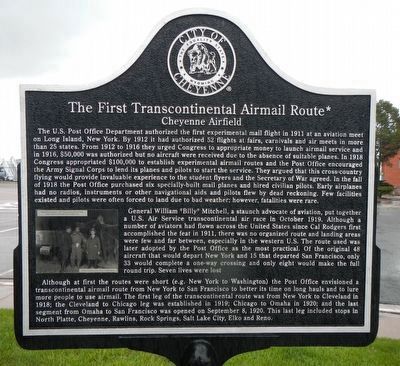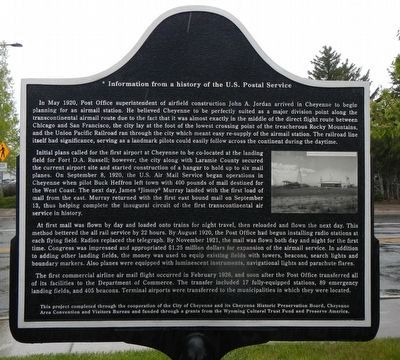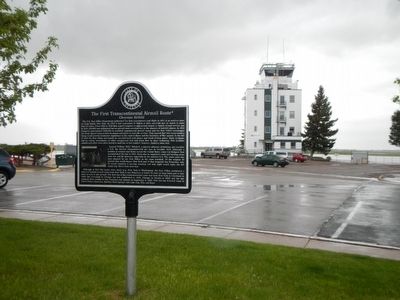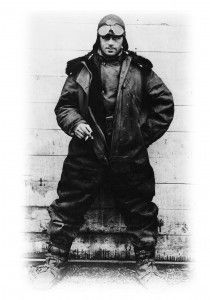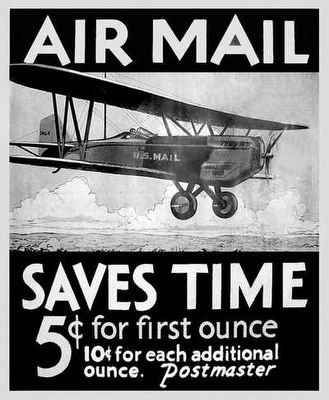Cheyenne in Laramie County, Wyoming — The American West (Mountains)
The First Transcontinental Airmail Route*
Inscription.
The U.S. Post Office Department authorized the first experimental mail flight in 1911 at an aviation meet on Long Island, New York. By 1912 it had authorized 52 flights at fairs, carnivals and air meets in more than 25 states. From 1912 to 1916 they urged Congress to appropriate money to launch airmail service and in 1916, $50,000 was authorized but no aircraft were received due to the absence of suitable planes. In 1918 Congress appropriated $100,000 to establish experimental airmail routes and the Post Office encouraged the Army Signal Corps to lend its planes and pilots to start the service. They argued that this cross-country flying would provide invaluable experience to student flyers and the Secretary of War agreed. In the fall of 1918 the Post Office purchased six specially-built mail planes and hired civilian pilots. Early airplanes has no radios, instruments or other navigational aids and pilots flew by dead reckoning Few facilities existed and pilots were often forced to land due to bad weather; however, fatalities were rare.
General William "Billy" Mitchell, a staunch advocate of aviation, put together a U.S. Air Service transcontinental air race in October 1919. Although a number of aviators had flown across the United States since Cal Rodgers first accomplished the feat in 1911, there was no organized route and landing areas were few and far between, especially in the western U.S. The route used was later adopted by the Post Office as the most practical. Of the original 48 aircraft that would depart New York and 15 that departed San Francisco, only 33 would complete the one-way crossing and only eight would make the full round trip. Seven lives were lost.
Although at first the routes were short (e.g. New York to Washington) the Post Office envisioned a transcontinental airmail route from New York to San Francisco to better its time on long hauls and to lure more people to use airmail. The first leg of the transcontinental route was from New York to Cleveland in 1918; the Cleveland to Chicago leg was established in 1919; Chicago to Omaha in 1920; and the last segment from Omaha to San Francisco was opened on September 8, 1920. This last leg included stops in North Platte, Cheyenne, Rock Springs, Salt Lake City, Elko and Reno.
In May 1920, Post Office superintendent of airfield construction John A. Jordan arrived in Cheyenne to begin planning for an airmail station. He believed Cheyenne to be perfectly suited as a major division point along the transcontinental airmail route due to the fact that it was almost exactly in the middle of the direct flight route between Chicago and San Francisco, the city lay at the foot of the lowest crossing point of the treacherous Rocky Mountains,
and the Union Pacific Railroad ran through the city which meant easy re-supply of the airmail station. The railroad line itself had significance, serving as a landmark pilots could easily follow across the continent during the daytime.
Initial plans called for the first airport at Cheyenne to be co-located at the landing field for Fort D.A. Russell; however, the city along with Laramie County secured the current airport site and started construction of a hangar to hold up to six mail planes. On September 8, 1920, the U.S. Air Mail Service began operations in Cheyenne when pilot Buck Heffron left town with 400 pounds of mail destined for the West Coast. The next day, James "Jimmy" Murray landed with the first load of mail from the east. Murray returned with the first east bound mail on September 13, thus helping complete the inaugural circuit of the first transcontinental air service in history.
The first mail was flown by day and loaded onto trains for night travel, then reloaded and flown the next day. This method bettered the all rail service by 22 hours. By August 1920, the Post Office had begun installing radio stations at each flying field. Radios replaced the telegraph. By November 1921, the mail was flown both day and night for the first time. Congress was impressed and appropriated $1.25 million dollars for expansion of the airmail service. In addition to adding other landing fields, the money was used to equip existing fields with towers, beckons, search lights and boundary markers. Also planes were equipped with luminescent instruments, navigation lights and parachute flares.
The first commercial airline air mail flight occurred in February 1926, and soon after the Post Office transferred all of its facilities to the Department of Commerce. The transfer included 17 fully-equipped stations, 89 emergency landing fields, and 405 beacons. Terminal airports were transferred to the municipalities in which they were located.
* Information from a history of the U.S. Postal Service.
Erected by City of Cheyenne, Cheyenne Historic Historic Preservation Board, Cheyenne Area Convention and Visitors Board, Wyoming Cultural Trust Fund and Preserve America.
Topics and series. This historical marker is listed in these topic lists: Air & Space • Communications. In addition, it is included in the Postal Mail and Philately series list. A significant historical date for this entry is September 8, 1920.
Location. 41° 9.159′ N, 104° 49.136′ W. Marker is in Cheyenne, Wyoming, in Laramie County. Marker is on Evans Avenue near East 7th Street, on the left when traveling north. Touch for map. Marker is at or near this postal address: 4101 Evans Avenue, Cheyenne WY 82001, United States of America. Touch for directions.
Other nearby markers. At least 8 other markers are within walking distance of this marker. Aviation in Cheyenne (1920-1930s) (about 300 feet away, measured in a direct line); Aviation in Cheyenne (1930-1950s) (about 500 feet away); Early Cheyenne Reservoir (approx. 0.7 miles away); Union Pacific Steam Engine #1242 (approx. 0.8 miles away); Floyd and Edna Young Folk Art Fence (approx. 0.8 miles away); The Trails (Part I) (approx. 0.8 miles away); Cheyenne Frontier Days™ (Part I) (approx. 0.8 miles away); Cheyenne Frontier Days™ (Part II) (approx. 0.8 miles away). Touch for a list and map of all markers in Cheyenne.
Also see . . .
1. The "Highway of Light" That Guided Early Planes Across America - Paleofuture. ...enormous (concrete) arrows pointing west...Because at the dawn of aviation, they were part of America's highway of light — a high-tech system of lighthouses showing pilots how to get from New York City all the way to San Francisco. (Submitted on June 27, 2016, by Barry Swackhamer of Brentwood, California.)
2. Airmails of the United States - Wikipedia. After an intermittent series of government sponsored experimental flights between 1911 and 1918, domestic U.S. Air Mail was formally established as a new class of service by the United States Post Office Department on May 15, 1918, with the inauguration of the Washington-Philadelphia-New York route for which the first of special Air Mail stamps were issued. (Submitted on June 27, 2016, by Barry Swackhamer of Brentwood, California.)
Credits. This page was last revised on June 27, 2016. It was originally submitted on June 27, 2016, by Barry Swackhamer of Brentwood, California. This page has been viewed 1,065 times since then and 91 times this year. Photos: 1, 2, 3, 4, 5. submitted on June 27, 2016, by Barry Swackhamer of Brentwood, California.
